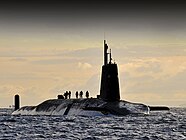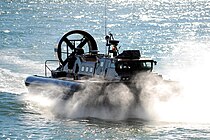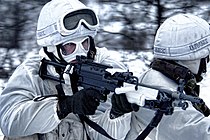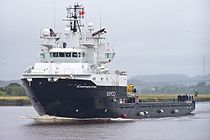| His Majesty's Naval Service | |
|---|---|
 | |
| Country | |
| Type | Naval warfare and maritime service |
| Role | Naval, expeditionary and amphibious warfare |
| Part of | |
| Garrison/HQ | Whitehall / Portsmouth |
| Branches | |
| Commanders | |
| First Sea Lord | Admiral Sir Ben Key |
| Second Sea Lord | Vice Admiral Martin Connell |
| Fleet Commander | Vice Admiral Andrew Burns |
| Insignia | |
| White Ensign |  |
 |
| His Majesty's Naval Service of the British Armed Forces |
|---|
| Components |
|
| History and future |
| Operations |
| Equipment |
| Personnel |
| Auxiliary services |
His Majesty's Naval Service (or, when the reigning monarch is female, Her Majesty's Naval Service) is the United Kingdom's naval warfare and maritime service. It consists of the Royal Navy, Royal Marines, Royal Fleet Auxiliary, Royal Naval Reserve, Royal Marines Reserve and Naval Careers Service. The Naval Service as a whole falls under the command of the Navy Board, which is headed by the First Sea Lord. This position is currently held by Admiral Sir Ben Key (appointed November 2021). The Defence Council delegates administration of the Naval Service to the Admiralty Board, chaired by the Secretary of State for Defence.
The Naval Service is dominated by the Royal Navy, and operates primarily from three bases in the United Kingdom where commissioned ships are based; Portsmouth, Clyde and Devonport, the last being the largest operational naval base in Western Europe. As of December 2024, there were about 90 vessels in service with the various branches of the Naval Service, plus about 100 additional vessels operated by the supporting Serco Marine Services. These vessels included: 62 commissioned ships of the Royal Navy, 17 principal landing craft of the Royal Marines, 11 auxiliary ships of the Royal Fleet Auxiliary and about 100 supporting Marine Services vessels. Additional vessels are under charter to the Ministry of Defence. As of 2022, HM Naval Service (Royal Navy, Royal Marines, Royal Fleet Auxiliary and Naval Careers Service) employed about 39,500 regular and reserve personnel.
In 2020, the First Sea Lord announced that the 'Naval Service' will informally be known as the 'Royal Navy'. The Royal Navy was made a colloquial name for the Naval Service as part of a transformation programme with the approval of the Navy Executive Committee to reflect the strength of the Royal Navy brand and assist with unifying the force.
The total displacement of the Royal Navy and the Royal Fleet Auxiliary is, as of December 2024, around 671,000 tonnes, while the combined displacement of Royal Marine landing craft is approximately an additional 2,200 tonnes.
King's Regulations for the Royal Navy
Components as of 2017
The 2017 Queen's Regulations for the Royal Navy stipulate that the Naval Service consists of:
- The Royal Navy (Royal Naval Reserve) - including Queen Alexandra's Royal Naval Nursing Service
- The Royal Marines (Royal Marines Reserve)
- Naval Careers Service
The Royal Fleet Auxiliary (RFA) operate a fleet of auxiliaries in support of the Royal Navy. RFA personnel are part of the Ministry of Defence civil service. Among the many contractors which support the Ministry of Defence and Royal Navy is Serco Marine Services, provided under a private finance initiative.
Former composition
The following services were formerly also components of the Naval Service:
- The Women's Royal Naval Service (merged into the Royal Navy in 1993)
- The Royal Naval Minewatching Service (reformed into the Royal Naval Auxiliary Service in 1962 and disbanded in 1994)
- The Queen Alexandra's Royal Naval Nursing Service (incorporated within the Royal Navy in 2000)
Naval Reserve Forces:
- The Royal Naval Volunteer Reserve (merged with the Royal Naval Reserve in 1958)
- The Royal Naval Volunteer (Supplementary) Reserve
- The Royal Naval Volunteer (Wireless) Reserve
- The Royal Naval Volunteer (Postal) Reserve)
- The Royal Naval Emergency Reserve (disbanded c. 1959)
- The Royal Naval Special Reserve (disbanded c. 1960)
- The Women's Royal Naval Volunteer Reserve (renamed the Women's Royal Naval Reserve in 1958, merged into the Royal Naval Reserve in 1993)
- The Women's Royal Naval Supplementary Reserve
- The Queen Alexandra's Royal Naval Nursing Service Reserve (incorporated within the Royal Naval Reserve in 2000)
Formerly the Royal Maritime Auxiliary Service, the Fleet Reserve, and the Royal Corps of Naval Constructors were also considered part of the Naval Service.
Composition of the Naval Service
Royal Navy
Main article: Royal NavyReferred to as the "Senior Service" by virtue of it being the oldest service within the British Armed Forces, the Royal Navy is a technologically sophisticated naval force and forms the core structure of the Naval Service. Command of deployable assets is exercised by the Fleet Commander. The United Kingdom's nuclear deterrent is carried aboard the navy's Vanguard class of four nuclear ballistic-missile submarines. The surface fleet consists of aircraft carriers, destroyers, frigates, patrol ships, mine-countermeasures, and miscellaneous vessels. The submarine service has existed within the Royal Navy for more than 100 years. The service possessed a combined fleet of diesel-electric and nuclear-powered submarines until the early 1990s. Following the Options for Change defence review, the Upholder-class diesel-electric submarines were withdrawn and the attack submarine flotilla is now exclusively nuclear-powered.
-
 HMS Queen Elizabeth on sea trials in June 2017
HMS Queen Elizabeth on sea trials in June 2017
-
 HMS Vanguard, a Vanguard-class ballistic missile submarine
HMS Vanguard, a Vanguard-class ballistic missile submarine
-
 HMS Diamond, a Type 45 guided missile destroyer
HMS Diamond, a Type 45 guided missile destroyer
Royal Marines
Main article: Royal MarinesThe infantry component of the Naval Service is the Corps of Royal Marines. Consisting of a single manoeuvre brigade (UK Commando Force) and various independent units, the Royal Marines specialise in amphibious, arctic, and mountain warfare. Contained within the UK Commando Force are attached army units; 29 Commando Regiment Royal Artillery, an artillery regiment based in Plymouth, and 24 Commando Regiment Royal Engineers. Both regiments have Commando REME detachments. The Commando Logistic Regiment consists of personnel from the Army, Royal Marines, and Royal Navy.
-
 Mk5 Landing Craft Vehicle Personnel
Mk5 Landing Craft Vehicle Personnel
-
 2000TDX Landing Craft Air Cushion
2000TDX Landing Craft Air Cushion
-
 Royal Marines during the annual Cold Weather Training exercise
Royal Marines during the annual Cold Weather Training exercise
Royal Fleet Auxiliary
Main article: Royal Fleet AuxiliaryThe Royal Fleet Auxiliary is a civilian-manned fleet owned by the British Ministry of Defence. The RFA enables ships of the Royal Navy to maintain operations around the world. Its primary role is to supply the Royal Navy with fuel, ammunition and supplies, normally by replenishment at sea (RAS). It also transports Army and Royal Marine personnel, as well as supporting training exercises. RFA personnel are members of the Ministry of Defence civil service who wear Merchant Navy rank insignia with naval uniforms and are under naval discipline when the vessel is engaged on warlike operations. RFA vessels are commanded and crewed by these civilians, augmented with regular and reserve Royal Navy personnel to perform specialised military functions such as operating and maintaining helicopters or providing hospital facilities. The RFA is funded out of the UK defence budget and the Commodore commanding the RFA is directly responsible to the Royal Navy Fleet Commander.
The Royal Fleet Auxiliary also provides the naval service's principal amphibious warfare capability through its three Bay-class landing ship dock vessels. The service is manned by around 1,750 civilian personnel (as of late 2022).
-
 RFA Mounts Bay, a Bay-class landing ship
RFA Mounts Bay, a Bay-class landing ship
-
 RFA Fort Victoria, a replenishment oiler
RFA Fort Victoria, a replenishment oiler
-
 RFA Argus, an aviation training and casualty receiving ship
RFA Argus, an aviation training and casualty receiving ship
Naval Careers Service
Main article: Naval Careers ServiceThe Naval Careers Service is the recruiting arm of the Naval Service. It is manned by former Royal Navy and Royal Marine personnel who are typically based at Armed Forces Careers Offices. It is the smallest component of the Naval Service, comprising fewer than 200 personnel.
In support of the Naval Service
Marine Services, U.K.
Main article: Serco Marine ServicesMarine Services enables Royal Navy and Royal Fleet Auxiliary Ships, including the United Kingdom's Strategic Nuclear Deterrent, to either move in or out of port for operational deployment and training exercises around the world. The service operates a large assortment of vessels including tugs and pilot boats as well as transporting stores, liquid and munitions and providing passenger transfer services to and from ships for officers and crew. Serco Denholm took over Marine Services to the Naval Service from the now disbanded Royal Maritime Auxiliary Service in 2008. In late 2009 Serco bought out Denholm's share, with the service now being known as Serco Marine Services.
Marine Services, Gibraltar
Marine services at the Port of Gibraltar, including naval vessels using the port, are provided by Boluda Towage Europe. Boluda acquired Resolve Marine Group in 2024, which had been equipped with one ASD ocean-going and harbour tug (Resolve Hercules), four harbour tugs (Rooke, Wellington, Egerton and Eliott), two barges (Isaac 1874 and RMG 280) as well as the anchor-handling tug Resolve Blizzard, which provided regional firefighting, oil pollution and emergency response services. Several of these assets were acquired by Boluda which, in June 2024, also strengthened its own presence at Gibraltar by adding the tugboat “VB Responder” to its fleet.
Marine Services, Falkland Islands
As of 2021, marine services at the British military and naval port in the Falkland Islands, Mare Harbour, were provided by the contracted Netherlands Marine Services company Van Wijngaarden. The company operated two tugs (Giesenstroom and Dintelstroom) as well as a multi-purpose barge (MP2003) at the port.
-
 SD Northern River, a Marine Services multi-purpose ship
SD Northern River, a Marine Services multi-purpose ship
-
 SD Bountiful, a Marine Services ATD 2909-class tug
SD Bountiful, a Marine Services ATD 2909-class tug
-
 SD Navigator, a Marine Services Multicat 2510-class recovery vessel
SD Navigator, a Marine Services Multicat 2510-class recovery vessel
Lists of vessels
See the articles below for lists of vessels operated by or in support of His Majesty's Naval Service:
- List of active Royal Navy ships - 62 (plus two non-commissioned training vessels, one experimental ship and several dozen smaller boats)
- List of active Royal Marines military watercraft - 17 principal landing craft (plus three patrol boats and some 85 smaller Commando and inshore raiding craft; Special Boat Service operates additional specialist craft, including up to three combat submersibles)
- List of active Royal Fleet Auxiliary ships - 11 (plus five ships under charter to the MoD)
- List of ships of Serco Marine Services - up to 100 (plus additional vessels operated by other companies in certain overseas territories)
See also
- List of all naval vessels current and former of the United Kingdom
- British Armed Forces
- Royal Navy
- Royal Marines
- Royal Fleet Auxiliary
- His Majesty's Coastguard
- Border Force
- Special Boat Service (SBS)
- Royal Naval Association
Notes
-
- Kingdom of England (until 1707)
- Kingdom of Scotland (until 1707)
- Kingdom of Great Britain (1707–1800)
-
 1630–1707
1630–1707 Middle Ages–1707
Middle Ages–1707 1707–1800
1707–1800
References
Citations
- NAVAL PERSONNEL HIERARCHY, mod.uk. 5 October 2014.
- Her Majesty’s Naval Service Eligibility and Guidance Notes, mod.uk. 5 October 2014.
- ^ "Queen's Regulations for the Royal Navy" (PDF). Ministry of Defence. Retrieved 22 April 2017.
- "Vice Admiral Sir Ben Key KCB CBE has been appointed to First Sea Lord and Chief of the Naval Staff". gov.uk. 15 October 2021. Retrieved 8 November 2021.
- "Serco wins £200m contract to provide marine services for Royal Navy". Advance. 16 November 2022. Retrieved 30 April 2023.
- "The Royal Fleet Auxiliary in 2022". Navy Lookout. 30 May 2022.
- "Royal Naval Reserve". Royal Navy. Retrieved 4 May 2023.
- "Number of personnel in the armed forces of the United Kingdom between 2012 and 2022, by military branch". Statista. Retrieved 4 May 2023.
- "Royal Marines Reserve". Royal Navy. Retrieved 4 May 2023.
- "Adieu 'Naval Service,' Hello 'Royal Navy'" (PDF). Navy News (791). Ministry of Defence: 20. June 2020. ISSN 0028-1670. Retrieved 16 May 2022.
- First Sea Lord Admiral Tony Radakin. "The Whole Force: Naval Service to Royal Navy". Royal Navy Association. Retrieved 16 May 2022.
- BBC News (2002), UK's mountain warfare elite, news.bbc.co.uk
- The Commando Role for 1 RIFLER Archived 2009-01-14 at the Wayback Machine, army.mod.uk
- Commando Logistic Regiment Archived 2005-05-14 at the Wayback Machine, royalnavy.mod.uk
- "Navy struggling to keep RFA Fort Victoria operational". NavyLookout. 19 May 2023.
- "Queen's Regulations for the Royal Navy Chapter One" (PDF). Ministry of Defence. pp. 1–3. Retrieved 9 February 2018.
- "BR3 Volume One Naval Personnel Management Chapter Three" (PDF). Ministry of Defence. pp. 20–6. Retrieved 9 February 2018.
- "Royal Navy and Royal Marines Monthly Personnel Situation Report" (PDF). British Government. Ministry of Defence. Retrieved 9 February 2018.
- Bush, Steve (2014). British Warships and Auxiliaries. Maritime Books. p. 64. ISBN 978-1904459552.
- "Boluda acquires Resolve Fire and Salvage". Boluda Towage Europe. 7 February 2024. Retrieved 2024-08-07.
- "Tugs and Barges". Resolve Marine Services (Gibraltar). Retrieved 2023-06-15.
- "Resolving to Expand". Nautic Expo. Retrieved 2023-06-15.
- "Boluda strengthens its fleet in Gibraltar with a new boat". Boluda Towage Europe. 18 June 2024. Retrieved 2024-08-07.
- Childs (RN), Cdr J R (June 2021). "British Forces South Atlantic Islands East Cove Port Navigation Risk Assessment 2021" (PDF). Retrieved 17 May 2023.
- "Outsourcing giant Serco marks 25 years working with Royal Navy". BusinessLive. 12 August 2021. Retrieved 30 April 2023.
Sources
- BR 2 - Queen's Regulations for the Royal Navy
- BR1806 - British Maritime Doctrine, Glossary
- United Kingdom Defence Statistics 2005 - glossary
| Ministry of Defence | |||||||
|---|---|---|---|---|---|---|---|
| Headquarters: Main Building, Whitehall | |||||||
| Armed Forces |
| ||||||
| Defence Council |
| ||||||
| Service boards | |||||||
| Service commands | |||||||
| Arm's-length bodies |
| ||||||
| Top-level budget agencies managed on an arm's-length basis | |||||||
| Regulatory organisations | |||||||
| Intelligence |
| ||||||
| Non-departmental public bodies | |||||||
| Public corporations | |||||||
| British Armed Forces | |||||
|---|---|---|---|---|---|
| Head of the Armed Forces — King Charles III Prime Minister — Sir Keir Starmer Secretary of State for Defence — John Healey Chief of the Defence Staff — Admiral Sir Tony Radakin Vice-Chief of the Defence Staff — General Dame Sharon Nesmith | |||||